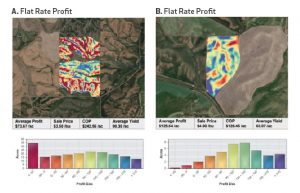When to Incorporate More Precision into your Crop Management Plans
October 3, 2017
Everyone is all hyped up over precision management, and there seems to be a sense that if you’re not variable rating some or all of your inputs, you’re somehow being left behind. But as Markus Braaten, AGRI-TREND Knowledge Team Lead and Senior Agri-Coach advocates, even the decision NOT to do precision management IS a precision decision.
Before we implement a precision management plan, we want to make sure that there is significant enough variability driving differences in productivity and affecting profitability — because our goal with precision management is to grow profitable bushels by managing that profitability. So, when should we incorporate more precision into our management? Braaten advises to start in the fields where your margins suggest you should. How? Start with the Profit Maps of your fields.
Before you implement any VR program, consult a profit map. At a single glance, you are able to see the areas not growing profitable bushels. This is where the cost of inputs and amendments is not paying off. Figure 1 Profit Map A is a field pencilled in for soft white winter wheat. In this field, significant of variability is affecting profitability, almost 25% of this field is losing this grower money.

From this profit map, he now knows where to investigate to determine the causal issues and whether they are fixable ñ physically, logistically or financially. He can then decide on a plan to those poorly producing zones that will keep them profitable. For the higher producing zones, he can decide whether is target yield and management practices are adequate or if they should be increased. For the average producing zones, he can decide whether to keep management the same or increase.
Figure 1 Profit Map B is a field also pencilled in for soft white winter wheat. In this field, there is definitely still work to do to understand the reason(s) for the low production but it might not be a field you start with if you have fields that look more like A.
The more the variability results in greater differences in cost per unit production between the low and high producing zones, the greater the opportunity there is to influence profitability through implementation of a precision plan. But don’t let lack of access to profit maps stop you. Utilize the imagery you have available PowerZone maps or satellite or yield maps. Pencil in ballpark yields by zone, do some quick math using input costs and sale prices and you have a rough guide. As more accurate numbers come in, you can refine this napkin math profit map.
Starting a precision management program with profit maps puts us in a much better place to measure ROI than does starting with a soil test, which is where we historically started. With a precision plan designed from a soil test, we are unable to answer the question of whether or not it worked. We cannot know if implementing the plan increased our profitability. Starting with profit maps lets profitability and the nature of the margin opportunity drive management decisions. Will these acres still be profitable after an in-season nitrogen application? What is the effect on profitability of a flat- rate fungicide application, what are the risks?
Starting with profit maps lets profitability drive the determination of management zones. Recognize that these zones will change year by year given the fluctuations of input costs and anticipated commodity value. Start using profit maps as a planning tool, rather than the postmortem of the year past. If you want to see an economic return from implementing precision management on your fields — precision being defined as the right rate and source in the right placement at the right time — it will require measuring results, adjusting the plan and measuring again.
Start with a profit map. Start in fields that have areas that are decreasing your profitability. Get better and better at tracking your costs, i.e. actual yields and sale price. Utilize the harvest data you have stored somewhere to refine profit maps. Review profit maps often throughout the growing season. Use the software and technology available to you through your Trimble Ag Software Farmer Pro account to simplify that effort. Ask your Agri-Coach for help with uploading harvest data, building profit maps and deciding where best to start and how best to reallocate scarce resources.
Let the margin dictate management.
And good luck!
